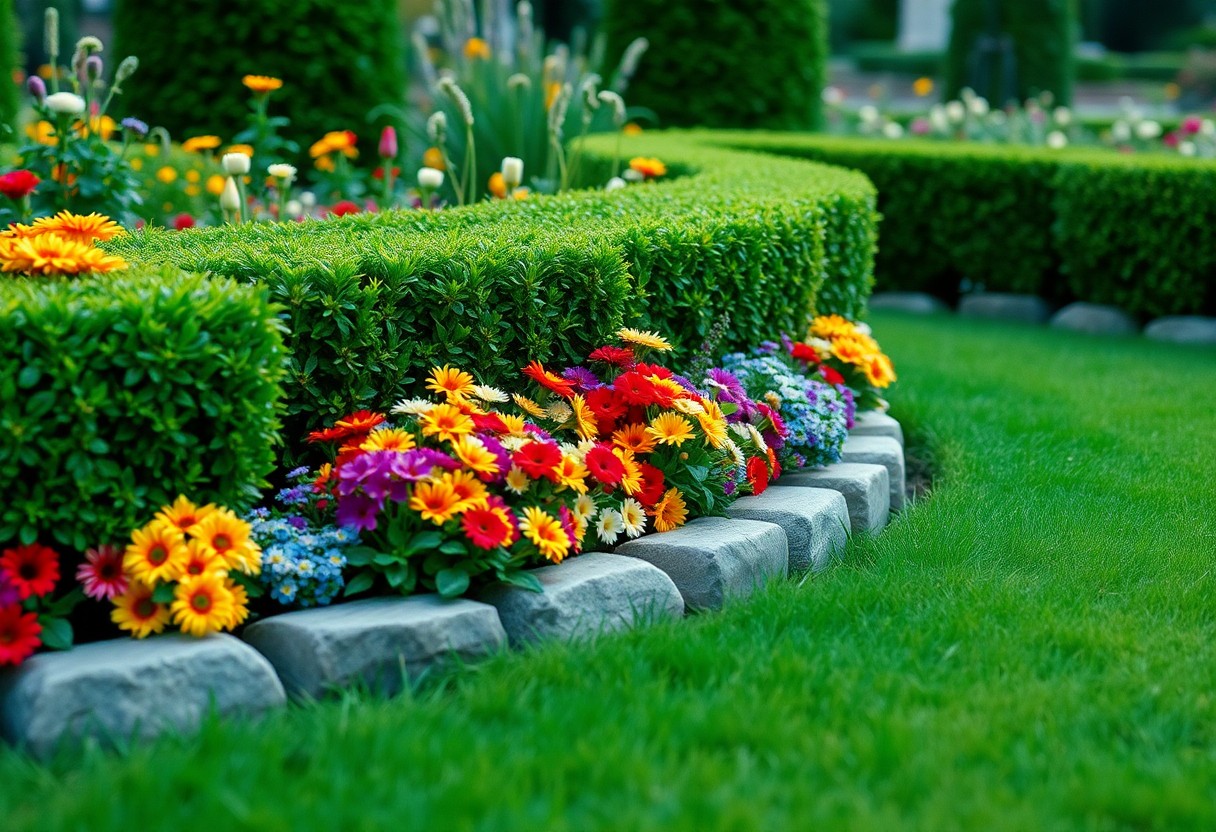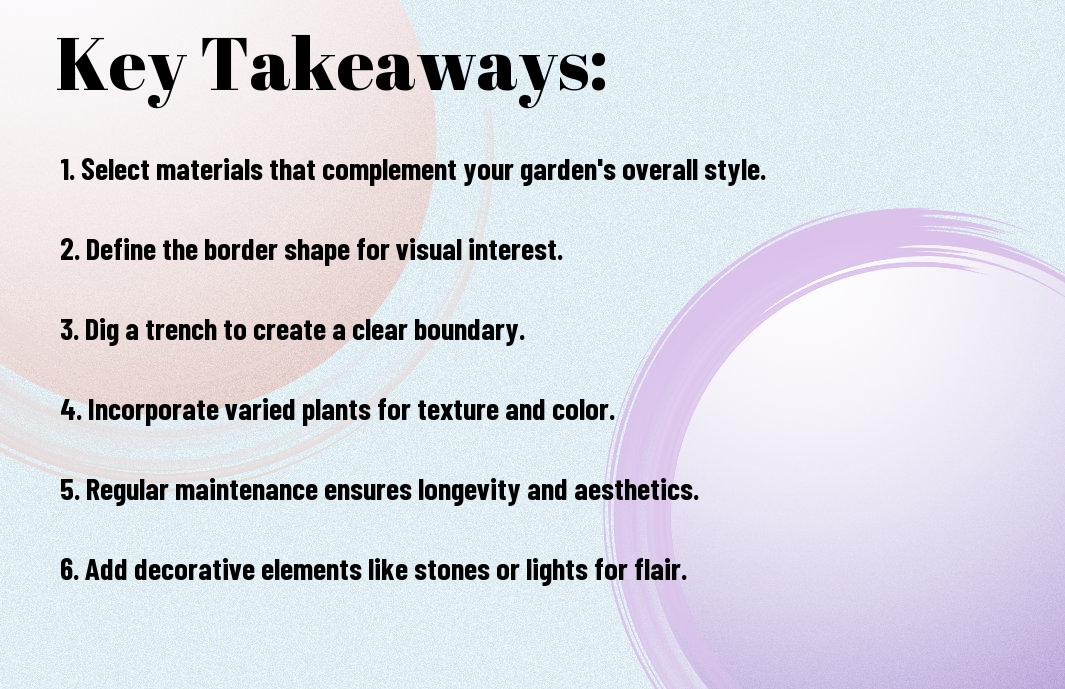As you step into your outdoor space, you want to be surrounded by beauty and serenity. Your garden border is the perfect place to start, and with a few simple steps, you can transform it into a stunning focal point. You can use a variety of materials and plants to create a unique and elegant look that reflects your personal style, adding texture, color, and depth to your garden, making it a haven that you’ll enjoy for years to come.
Key Takeaways:
To create a beautiful and functional decorative garden border, consider the following points:
- Choose a theme that fits your personal style and the overall aesthetic of your garden, such as a formal or cottage style, to guide your plant and material selections.
- Select a variety of plants with different textures, colors, and heights to add depth and visual interest to your border, and consider factors like sunlight and soil type when making your choices.
- Use hardscaping materials like stones, bricks, or wood to define the edge of your border and add a decorative element, and consider adding ornamental features like statues or birdbaths to enhance the overall ambiance of your garden.
Planning Your Garden Border
Your garden border is an opportunity to add a personal touch to your outdoor space. You can create a beautiful and functional border with a little planning and creativity. Consider the style and theme you want to achieve, as well as the plants and materials you will use.
Assessing Your Space
Against the backdrop of your existing landscape, evaluate the area where you want to create your garden border. Consider the amount of sunlight, soil type, and drainage in the area, as these factors will influence your plant choices.
Choosing a Theme
Assessing your personal style and preferences, you can select a theme that reflects your taste and complements your home’s architecture. You may opt for a modern, traditional, or whimsical theme, depending on your desired aesthetic.
In fact, choosing a theme is an exciting part of the process, as it allows you to express your creativity and vision. You can draw inspiration from various sources, such as nature, art, or architecture, to create a unique and beautiful garden border that reflects your personality and style, and enhances your outdoor space, making it a lovely retreat for you to enjoy.
Selecting Border Materials
Some of the most beautiful garden borders start with the right materials, and you can find inspiration online, such as on 37 Garden Edging Ideas To Dress Up Your Landscape Designs, to help you choose the perfect elements for your outdoor space.
Plants and Flowers
Besides the physical borders, you will want to select plants and flowers that complement your garden’s style and your personal taste, considering factors like color, texture, and growth habits to create a stunning display.
Decorative Elements
Bordering your garden with decorative elements can add a touch of elegance, and you can choose from a variety of items like stones, bricks, or wooden ornaments to enhance your garden’s beauty.
Understanding how to balance decorative elements with plants and other features is key to creating a harmonious and inviting garden border, and as you consider your options, think about how you want your garden to feel and look, and select elements that reflect your personal style and complement your outdoor space, allowing you to enjoy your beautiful garden border for years to come.
Designing Your Border
For a beautiful garden border, you’ll want to consider the overall aesthetic you’re aiming to achieve. Think about the style of your garden and the surrounding landscape to ensure your border complements its surroundings.
Creating a Focal Point
Developing a focal point in your border will draw the eye and create visual interest. You can achieve this by using a statement piece, such as a large statue or a vibrant plant, to anchor your design.
Balancing Texture and Color
Only by considering the textures and colors you use in your border can you create a harmonious and visually appealing space. You’ll want to balance smooth leaves with prickly stems and bright flowers with muted foliage to keep your border interesting.
Plus, to add depth and visual interest to your border, you can combine plants with different growing habits, such as upright and trailing varieties, and incorporate decorative elements like stones or bricks to enhance the overall design, ensuring your border is a beautiful frame for your garden.
Preparing the Site
Keep your garden border in mind as you prepare the site, considering the overall aesthetic you want to achieve. For a beautiful and unique edge, consider learning How to Create Natural Edging to add a personal touch to your garden.
Clearing and Cleaning
Beside the area where you plan to create your garden border, clear the space of any debris, weeds, or obstructions to give you a clean slate to work with, allowing you to envision your design more easily.
Edging and Marking
The first step in creating your decorative garden border is to define its boundaries, which will help guide your planting and design decisions, giving your garden a polished look.
Preparing your garden border’s edges and markings is an imperative part of the process, as it will help you establish a clear plan for your garden’s layout, allowing you to make the most of your space and create a beautiful, cohesive design that you will enjoy for years to come, and as you work on your edging and marking, you will start to see your garden vision take shape, helping you to make any necessary adjustments before planting.
Planting and Arranging
Now that you have prepared your garden border, it’s time to think about the fun part – planting and arranging your flowers, shrubs, and other decorative elements. You will want to consider the mature size of each plant, as well as their growing conditions and maintenance needs.
Plant Selection and Placement
One of the most important decisions you will make is selecting the right plants for your garden border. You should choose plants that fit your lifestyle and the specific conditions of your garden, such as sunlight and soil type, and place them in a way that creates a visually appealing arrangement.
Adding Decorative Features
Between the plants, you can add decorative features like stones, shells, or other ornaments to give your garden border a personal touch. You can use these features to create a cohesive look or add a pop of color and texture to your garden.
Features such as sundials, bird baths, or sculpture can add an extra layer of beauty and interest to your garden border. You can place them in a prominent spot, like a corner or a focal point, to draw the eye and create a sense of drama, making your garden border a unique and inviting space that reflects your personal style.

Maintenance and Upkeep
Despite the beauty of your decorative garden border, it will require some attention to keep it looking its best. You’ll need to stay on top of tasks to ensure your garden remains vibrant and healthy.
Watering and Pruning
Maintenance of your garden border involves regular watering and pruning to promote growth and prevent overgrowth. You should water your plants deeply but infrequently to encourage deep root growth, and prune them regularly to maintain shape and size.
Seasonal Refreshers
Beneath the surface of your garden border, there are opportunities to refresh and renew your design with each changing season. You can update your border with seasonal flowers, foliage, and decorations to keep it looking fresh and exciting.
And as you consider seasonal refreshers, think about how you can incorporate holiday-themed decorations, such as pumpkins in the fall or poinsettias in the winter, to add a personal touch to your garden border. You can also divide and replant perennials, and add new plants to keep your garden border looking vibrant and dynamic throughout the year.

To wrap up
With these considerations, you can create a decorative garden border that enhances your outdoor space. You will have a beautiful and thriving garden that showcases your personal style. By following these steps, you will be able to enjoy your lovely garden border for years to come, and your yard will be the envy of your friends and family. Your hard work will pay off, and you will have a stunning garden to enjoy.
FAQ
Q: What is the first step in creating a decorative garden border?
A: The first step in creating a decorative garden border is to plan and design the border. This involves deciding on the theme, style, and size of the border, as well as selecting the plants, materials, and features that will be included. It’s a good idea to sketch out a rough design and make a list of the materials and plants you’ll need before you start.
Q: What types of materials can be used to create a decorative garden border?
A: There are many different types of materials that can be used to create a decorative garden border, including brick, stone, wood, metal, and plastic. The choice of material will depend on the style and theme of the border, as well as the budget and personal preference. Some popular options include brick edging, stone walls, and wooden planters.
Q: How do I choose the right plants for my decorative garden border?
A: Choosing the right plants for your decorative garden border involves considering a number of factors, including the climate, soil type, and amount of sunlight the border will receive. You’ll also want to think about the color, texture, and size of the plants, and how they will work together to create a cohesive look. Some popular plants for garden borders include flowering shrubs, grasses, and perennials.
Q: Can I use recycled materials to create a decorative garden border?
A: Yes, recycled materials can be a great option for creating a decorative garden border. Old brick, stone, and wood can be reclaimed and reused to create a unique and eco-friendly border. Other recycled materials, such as plastic bottles and old CDs, can also be used to create decorative features like planters and wind chimes.
Q: How do I maintain my decorative garden border once it’s been created?
A: Maintaining a decorative garden border involves regular watering, weeding, and pruning to keep the plants healthy and looking their best. You’ll also want to check the border regularly for any damage or wear and tear, and make repairs as needed. Additionally, you may want to consider adding a layer of mulch or compost to the border to help retain moisture and suppress weeds.
